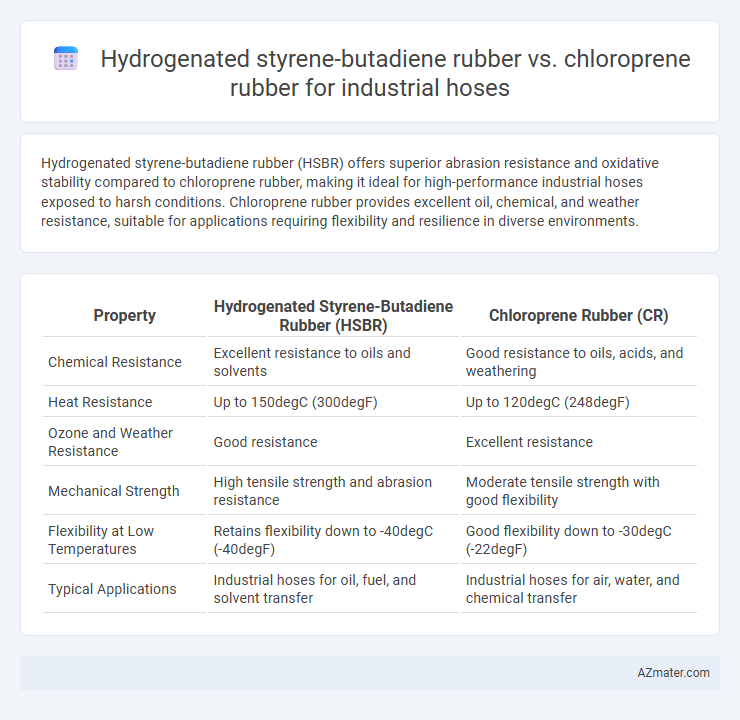Hydrogenated styrene-butadiene rubber (HSBR) offers superior abrasion resistance and oxidative stability compared to chloroprene rubber, making it ideal for high-performance industrial hoses exposed to harsh conditions. Chloroprene rubber provides excellent oil, chemical, and weather resistance, suitable for applications requiring flexibility and resilience in diverse environments.
Table of Comparison
| Property | Hydrogenated Styrene-Butadiene Rubber (HSBR) | Chloroprene Rubber (CR) |
|---|---|---|
| Chemical Resistance | Excellent resistance to oils and solvents | Good resistance to oils, acids, and weathering |
| Heat Resistance | Up to 150degC (300degF) | Up to 120degC (248degF) |
| Ozone and Weather Resistance | Good resistance | Excellent resistance |
| Mechanical Strength | High tensile strength and abrasion resistance | Moderate tensile strength with good flexibility |
| Flexibility at Low Temperatures | Retains flexibility down to -40degC (-40degF) | Good flexibility down to -30degC (-22degF) |
| Typical Applications | Industrial hoses for oil, fuel, and solvent transfer | Industrial hoses for air, water, and chemical transfer |
Introduction to Industrial Hose Rubber Materials
Hydrogenated styrene-butadiene rubber (HSBR) offers superior abrasion resistance and heat stability, making it ideal for industrial hoses exposed to harsh mechanical wear and elevated temperatures. Chloroprene rubber (CR), known for its excellent chemical resistance, ozone resistance, and flexibility, is widely used in hoses requiring durability against oils, solvents, and weathering. Choosing between HSBR and CR depends on specific industrial applications, considering factors such as chemical exposure, temperature range, and mechanical stress.
Overview of Hydrogenated Styrene-Butadiene Rubber (HSBR)
Hydrogenated Styrene-Butadiene Rubber (HSBR) offers superior resistance to heat, oxidation, and chemical degradation compared to standard SBR, making it highly suitable for industrial hose applications exposed to harsh environments. Its enhanced molecular structure reduces unsaturation, resulting in improved durability and longevity under dynamic mechanical stress. Industrial hoses made from HSBR provide excellent performance in oil processing, chemical transport, and high-temperature fluid transfer, outperforming Chloroprene rubber in thermal stability and resistance to aging.
Overview of Chloroprene Rubber (CR)
Chloroprene rubber (CR), commonly used in industrial hoses, offers excellent resistance to oil, chemicals, and weathering, making it ideal for harsh environments. It demonstrates superior flexibility at low temperatures and maintains durability against ozone and UV exposure compared to hydrogenated styrene-butadiene rubber (HSBR). CR's balanced physical properties and chemical stability provide enhanced performance in applications requiring abrasion resistance and prolonged service life.
Mechanical Properties Comparison: HSBR vs Chloroprene Rubber
Hydrogenated styrene-butadiene rubber (HSBR) offers superior tensile strength and enhanced abrasion resistance compared to chloroprene rubber, making it more durable for heavy-duty industrial hose applications. HSBR demonstrates excellent heat resistance and aging stability, maintaining mechanical integrity under high-temperature environments where chloroprene may exhibit faster degradation. Chloroprene rubber provides better flexibility and ozone resistance but generally falls short in mechanical strength and compression set performance relative to HSBR in demanding industrial conditions.
Chemical Resistance: HSBR vs Chloroprene Rubber
Hydrogenated styrene-butadiene rubber (HSBR) demonstrates superior chemical resistance compared to chloroprene rubber, particularly against oils, fuels, and solvents commonly encountered in industrial hose applications. HSBR's saturated polymer backbone provides enhanced stability in aggressive chemical environments, reducing swelling and degradation over time. While chloroprene rubber offers moderate resistance to chemicals and excellent weathering properties, it is less effective than HSBR when exposed to strong hydrocarbons and aromatic compounds.
Temperature Performance in Industrial Applications
Hydrogenated styrene-butadiene rubber (HSBR) offers superior temperature resistance, effectively withstanding continuous use temperatures up to 120degC and occasional spikes near 130degC, making it ideal for high-heat industrial hose applications. Chloroprene rubber (CR), also known as neoprene, provides reliable temperature performance with continuous use limits around 90degC and short-term exposure up to 120degC, suitable for moderate heat environments. The enhanced thermal stability of HSBR ensures better durability and longevity in demanding industrial conditions where elevated temperatures are frequently encountered.
Flexibility and Durability Analysis
Hydrogenated styrene-butadiene rubber (HSBR) offers superior flexibility due to its enhanced saturation and resistance to heat and oxidative degradation, making it ideal for industrial hoses subjected to dynamic bending. Chloroprene rubber (CR) provides excellent durability with strong resistance to ozone, weathering, and oil exposure, ensuring long service life in harsh chemical environments. Comparative analysis shows HSBR excels in flexibility for dynamic applications, while CR delivers robustness and environmental resistance suited for demanding industrial hose conditions.
Cost Efficiency and Availability
Hydrogenated styrene-butadiene rubber (HSBR) offers superior cost efficiency for industrial hose applications due to its lower raw material expense and longer service life compared to chloroprene rubber (CR). HSBR is highly resistant to abrasion and chemical degradation, reducing maintenance and replacement frequency, while chloroprene rubber provides better weather resistance but at a higher price point and more limited availability globally. Availability of HSBR is generally broader due to established synthetic rubber production networks, making it a preferred choice for budget-sensitive industrial hose manufacturers.
Environmental and Safety Considerations
Hydrogenated styrene-butadiene rubber (HSBR) offers superior chemical resistance and lower permeability compared to chloroprene rubber, reducing hazardous emissions during industrial hose operation. Chloroprene rubber contains chlorine atoms, which can produce harmful byproducts such as dioxins during disposal or incineration, posing environmental and health risks. HSBR's enhanced thermal stability and reduced toxicity contribute to safer handling and less environmental impact in industrial hose applications.
Application Suitability: Choosing the Right Rubber for Industrial Hoses
Hydrogenated styrene-butadiene rubber (HSBR) offers excellent resistance to heat, ozone, and abrasion, making it ideal for industrial hoses used in high-temperature and harsh chemical environments. Chloroprene rubber (CR) provides superior weather, oil, and flame resistance, which suits hoses exposed to outdoor conditions and petroleum-based fluids. Selecting between HSBR and CR depends on specific application requirements such as chemical exposure, temperature range, and mechanical stress for optimal hose performance.

Infographic: Hydrogenated styrene-butadiene rubber vs Chloroprene rubber for Industrial hose
 azmater.com
azmater.com